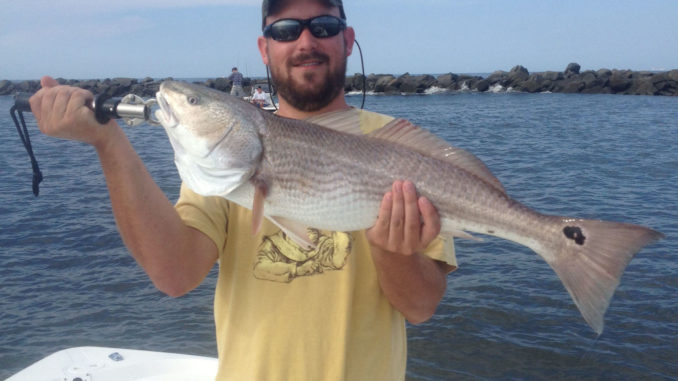
Long, rock structures attract plenty of bait, predator fish
Anglers fishing along South Carolina’s northern coastline have plenty of places to wet a line for some of the best fishing the state has to offer. And for speckled trout, red drum, sheepshead and flounder to Spanish mackerel, bluefish, and king mackerel, there are few places available than the rock jetties lining the numerous inlets. It needs to be on the list of places to fish each and every day.
Anglers along the Grand Strand are in luck, because the area is jetty rich, with three pairs to choose from: Little River, Murrells Inlet and Winyah Bay. Additionally, there are nearly a dozen rock “groins” protruding from Pawley’s Island and Litchfield Beach’s shorelines.
While many recreational anglers visit the jetties as their No. 1 place to fish, many guides recognize the importance of these rock structures every day.
Out of Murrells Inlet, Capt. J Baisch of Fishfull Thinking Guide Service is a regular at his jetties.
“I start at the jetties most of the time,” said Baisch (843-902-0356). “During the fall trout season, the big ones almost always come from the jetties.”
Big speckled trout, doormat flounder and bull reds spend plenty of time along the jetties throughout the year, and outside them, a few king mackerel and cobia are usually on hand looking for an easy meal.
Even though jetties are constructed to protect navigation in and out of the inlet, the massive rock structures are undoubtedly the best places for predator fish to find a seemingly unlimited supply of food. With the tidal flow constantly moving water in and out of nutrient-rich estuaries, jetties are perfectly located for creating ambush positions for toothy predators.
Capt. Mark Stacy of Ocean Isle Fishing Charters routinely spends his preferred tidal sequences at the jetties throughout the year, including the hot days of summer and the coldest winter days.
“There are few times when the jetties are not producing fish for me,” said Stacy (910-279-0119). “Poor weather conditions are usually the only times when I fail to drift live baits or cast artificial lures down the rocks at Little River. It is for sure a go to place, and I always recommend anglers to hit the jetties a few times throughout the day on different tides.”
It may not be the only place Stacy fishes in a given day, but it will always been on the itinerary to put his clients on fish and it is usually near the top.
The jetties are unique in that they offer four sides – the inside and outside of both long sets of rocks – that can be equally good at different periods of the tide. The currents formed from longshore currents and tides create a myriad of unique habitats that fish will learn to inhabit and gather food.
Anglers should always fish all four sides of the jetties due to the changing currents and migration patterns of fishes. Predators will set up in different places along the jetties during these different time periods to take advantage of the most prevalent bait source.
Fish will generally line up along the jetties’ northern sides during the fall, when fish are migrating to the south. The opposite will occur in the springtime. And anglers can count on the ends of the jetties becoming a hot spot on the incoming and outgoing tides. A few places created by irregular rock placement and scour holes will provide unique opportunities.




Be the first to comment